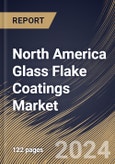This resin, derived from the reaction of epoxy resin with acrylic or methacrylic acid, offers a versatile solution for various coating applications, particularly in environments prone to harsh chemicals, corrosion, and abrasion. When combined with glass flakes, which serve as reinforcement, the resulting composite exhibits superior mechanical properties, including enhanced tensile strength and impact resistance. Therefore, the US market consumes 366.66 hundred tonnes of glass flake coatings in production of vinyl ester by 2030.
The US market dominated the North America Glass Flake Coatings Market by Country in 2022 and would continue to be a dominant market till 2030; thereby, achieving a market value of $349.4 Million by 2030. The Canada market is experiencing a CAGR of 6.2% during (2023 - 2030). Additionally, The Mexico market would exhibit a CAGR of 5.3% during (2023 - 2030).
Glass flake coatings are used in chemical processing plants to protect storage tanks, reactors, and vessels from corrosive chemicals. The coatings’ chemical resistance ensures the longevity and safety of equipment in environments where exposure to corrosive substances is common. Glass flake coatings are applied to the underbodies of vehicles to protect against corrosion caused by road salts, water, and environmental factors. These coatings contribute to the overall durability and longevity of automotive components.
Additionally, glass flake coatings protect steel and concrete structures like bridges and buildings from corrosion and environmental degradation. The coatings enhance the structural integrity of infrastructure, reducing maintenance needs over time. In water treatment plants, glass flake coatings are applied to pipelines and equipment to resist corrosion caused by water and chemical exposure, ensuring the longevity of critical infrastructure. Glass flake coatings find application in the mining industry to protect equipment exposed to abrasive materials.
In November 2023, Canadian manufacturing sales increased by 1.2% to $71.7 billion, as reported by Statistics Canada. The automotive manufacturing sector, a significant contributor to the Canadian economy, relies on coatings that provide corrosion protection for vehicles and manufacturing equipment. Hence, the factors mentioned above will drive the regional market growth.
Based on Material, the market is segmented into Epoxy, Vinyl Ester, and Polyester. Based on End Use, the market is segmented into Marine, Oil & Gas, Chemical, Industrial, Construction, and Others. Based on countries, the market is segmented into U.S., Mexico, Canada, and Rest of North America.
List of Key Companies Profiled
- Akzo Nobel N.V.
- Hempel A/S
- PPG Industries, Inc.
- KCC Corporation (Momentive Performance Materials Inc.,)
- Kansai Paint Co., Ltd.
- Berger Paints India Limited
- The Sherwin-Williams Company
- Jotun A/S
- Deccan Mechanical & Chemical Industries Pvt. Ltd
- Chugoku Marine Paints, Ltd.
Market Report Segmentation
By Material (Volume, Hundred Tonnes, USD Billion, 2019-2030)- Epoxy
- Vinyl Ester
- Polyester
- Marine
- Oil & Gas
- Chemical
- Industrial
- Construction
- Others
- US
- Canada
- Mexico
- Rest of North America
Table of Contents
Companies Mentioned
- Akzo Nobel N.V.
- Hempel A/S
- PPG Industries, Inc.
- KCC Corporation (Momentive Performance Materials Inc.,)
- Kansai Paint Co., Ltd.
- Berger Paints India Limited
- The Sherwin-Williams Company
- Jotun A/S
- Deccan Mechanical & Chemical Industries Pvt. Ltd
- Chugoku Marine Paints, Ltd.









